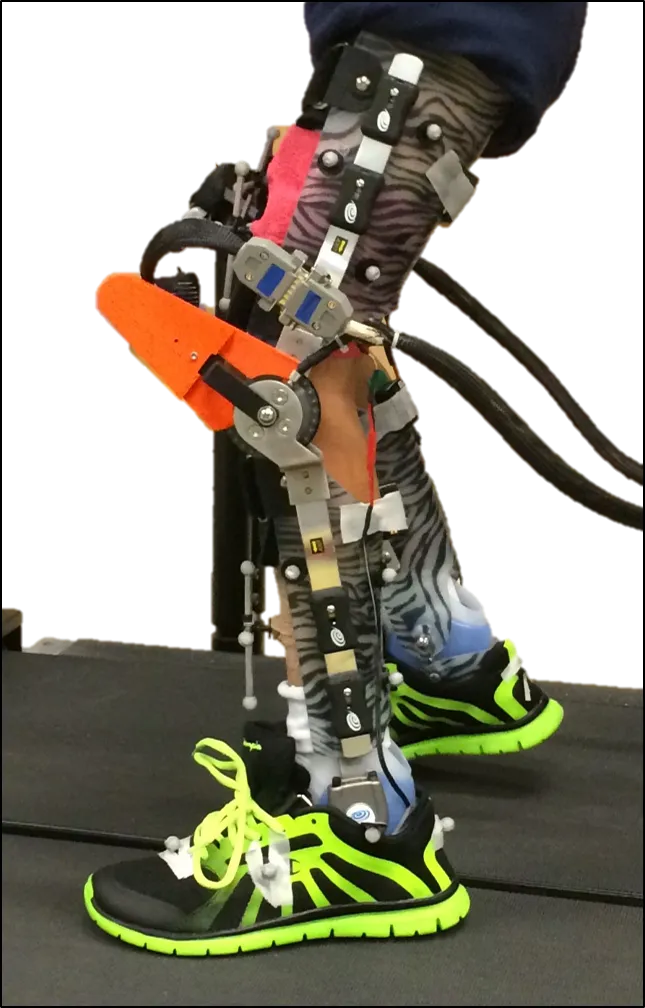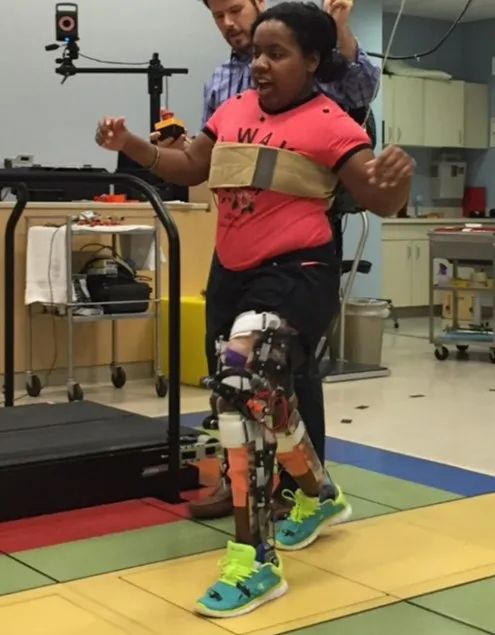This Robotic Exoskeleton Helps Kids With Cerebral Palsy Walk Upright
Children with cerebral palsy often walk in a crouched position, which is difficult to maintain over long distances. A robot suit can help.
/https://tf-cmsv2-smithsonianmag-media.s3.amazonaws.com/filer/60/f4/60f42d4e-efd3-4cc0-add0-803bb66b7b3b/exo_schematic.png)
At the National Institutes of Health (NIH) Clinical Center in Bethesda, Maryland, children with cerebral palsy are donning exoskeletons to help them learn to walk more effectively. And they’re happy to do it, in part because of the billion-dollar franchise of Iron Man movies.
“These kids actually were pretty excited to put on these braces, and a couple of them remarked that they were similar to superheroes,” says Thomas Bulea, a staff scientist in the NIH Clinical Center Department of Rehabilitation Medicine.
Cerebral palsy is the leading cause of childhood disability, affecting about 3.3 children per 1,000 births. It’s a group of neurological movement disorders caused by brain malformation or injury before, during or shortly after birth. Children and adults with cerebral palsy may have limb weakness, overly tight muscles, tremors and lack of coordination.
One of the biggest issues for many people with cerebral palsy is known as “crouch gait,” or walking while the knees are excessively bent. Children with cerebral palsy will often naturally walk in a crouch position because their muscles are too weak to hold them upright or too tight to let them fully extend their legs. But walking in this position uses up an immense amount of energy. And while it may be sustainable while a child is small and light, once they grow bigger and heavier it becomes increasingly difficult to move around in a crouch position.
“That results in a downward cycle where mobility—the ability to walk—deteriorates,” Bulea says.
By adulthood, many people who once walked with a crouch gait can no longer walk at all.
That’s where the exoskeleton comes in. The suit, a series of mechanized metal supports fitted on the legs, gives assistance with knee extension at key points in the walking cycle, allowing the children to extend their legs more than they normally could.

Bulea and his team studied seven children with cerebral palsy over a period of six clinic visits. At each visit, the child would walk with the exoskeleton while researchers studied his or her gait. The results were promising, Bulea says. Six out of the seven children had improvements in knee extension similar to or greater than those seen with surgery, one of the conventional treatments for crouch gait. The nature of the surgery depends on the exact cause of the crouch gait in the particular child, but often involves lengthening contracted muscles and tendons. The children also maintained muscle activity, which means they were still relying on their own strength and not just leaning on the suit.
“That’s a really encouraging sign that over long-term use, this brace might be a viable way to change posture, but also to train and exercise muscles,” Bulea says.
The research was published in the journal Science Translational Medicine.
The next step is a larger trial where children will use exoskeletons at home for a year or more. Bulea and his team hope the exoskeletons will allow some children to improve their walking enough that they no longer need external support. For other children with more severe gait problems, the exoskeleton might be kept for use on occasion, such as when walking for a long distance.
The team would also like to test the exoskeleton on children with mobility problems related to spina bifida or spinal cord injuries.
Bulea estimates it will be several years before his research is finished and the exoskeleton is ready for mass production.

Exoskeletons have been having a moment in recent years. Researchers have developed robotic exoskeletons that let people with stroke or spinal cord injuries stand and walk, allow construction workers and soldiers to carry heavy items with less fatigue and risk of injury, and give people with paralysis the ability to move using their thoughts. But the exoskeletons have not done well transitioning from research lab to market. They’re usually quite expensive, for one, ranging from between about $40,000 and $100,000. And experts say they are often still too bulky and complex to be especially useful in a home setting. Some even wonder if the emphasis on walking upright is a form of ableism that suggests walking is "more normal" than using a wheelchair, and that a better use of resources would be to make our cities more accessible to people who use mobility devices.
All prior research on exoskeletons has been done on adults, Bulea says. He’s excited to have shown that the technology can be effective on children too. For them, exoskeletons could actually help maintain a skill they currently have but are at risk of losing: the ability to walk.
“The earlier you intervene, the better the chance for a more successful outcome,” he says.
/https://tf-cmsv2-smithsonianmag-media.s3.amazonaws.com/accounts/headshot/matchar.png)


/https://tf-cmsv2-smithsonianmag-media.s3.amazonaws.com/accounts/headshot/matchar.png)